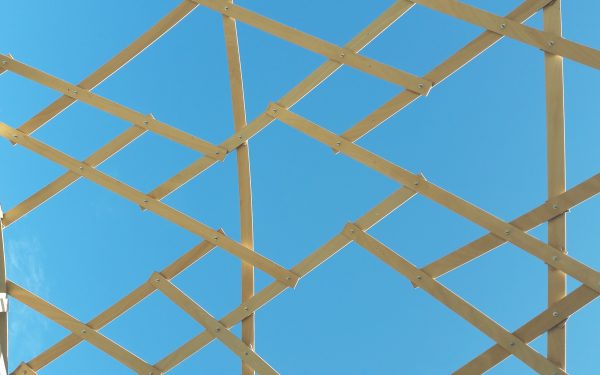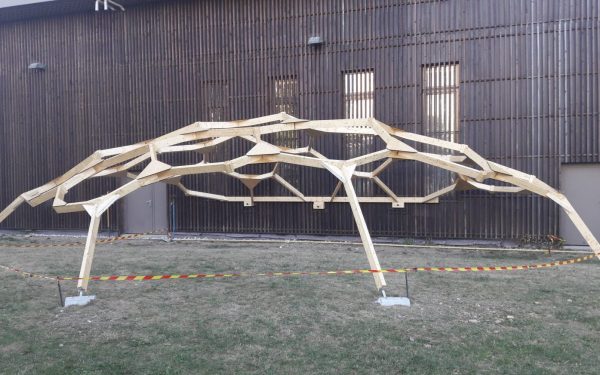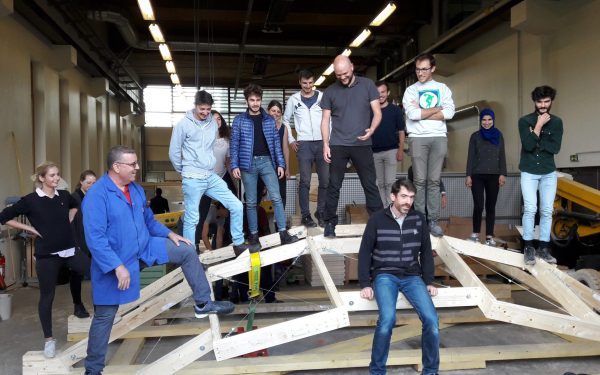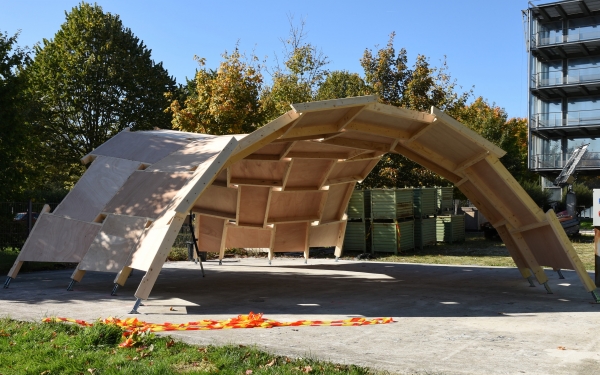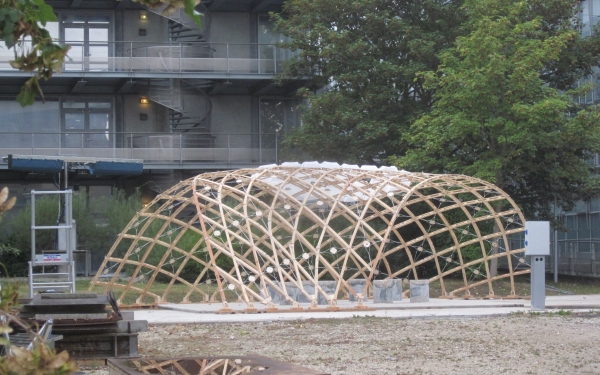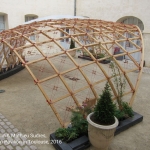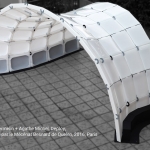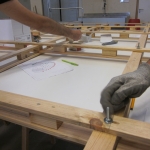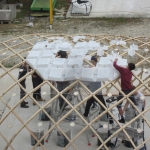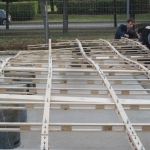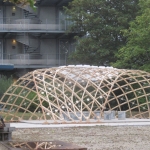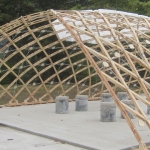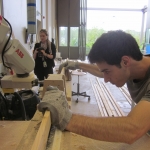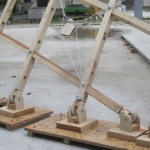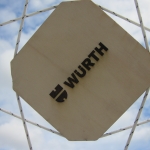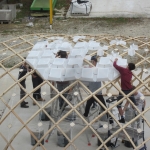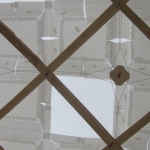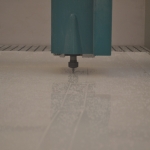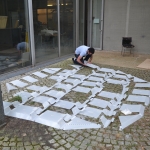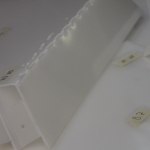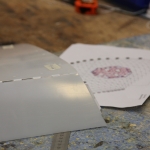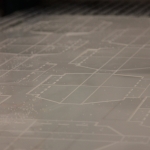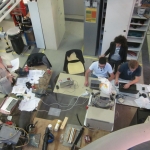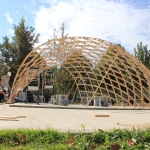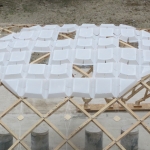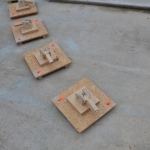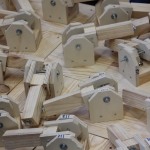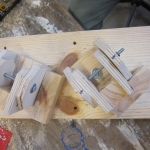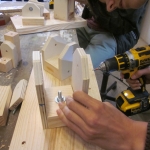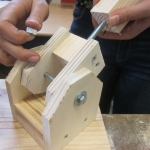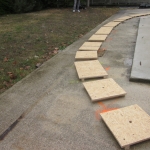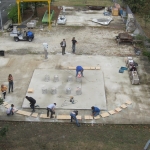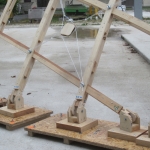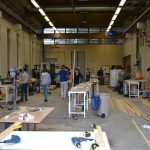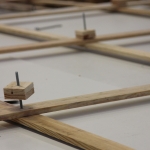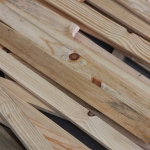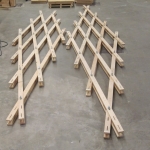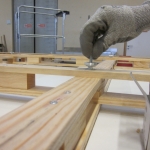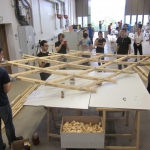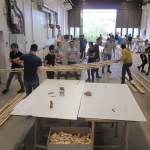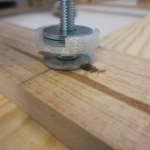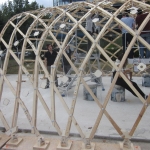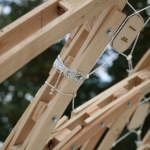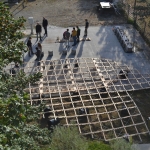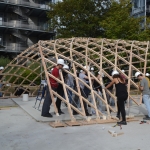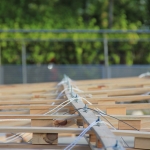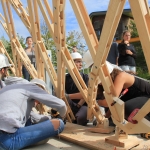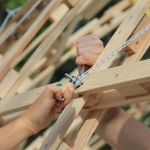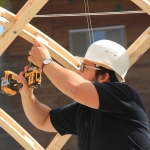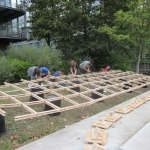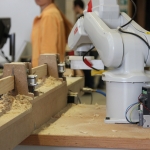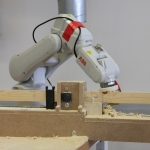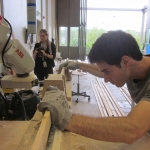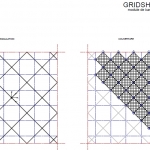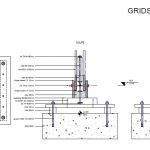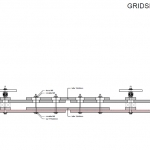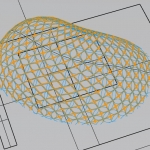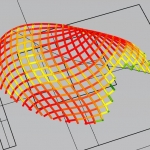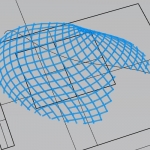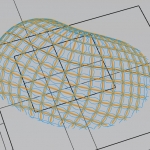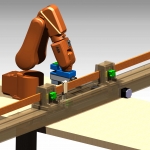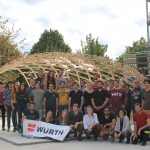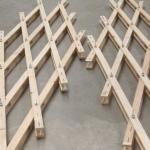@ENPC – Sept. 2016 – C. Douthe, L. du Peloux, R. Mesnil, P. Margerit, T. Gobin
Everything changes for this new edition of the intensive workshop dedicated to double curved structures and the discovery of their design and their manufacturing method. A wooden gridshell at full scale will be built, with more attention for structural analysis, details design and mechanics of materials. Nonetheless they will be strong use of digital manufacturing tools (e.g. parametric design, laser cutter, CNC and robotic manufacturing).
Learning Objectives
Most of the week is organized around the realization of a wooden elastic gridshell at full scale that will illustrate the concepts covered in the introductory lectures: mastery of geometry, design of slender structures, details design, especially in wooden structures, manufacturing , tolerance and automation, organization , methods and site safety.
A wooden gridshell for a temporary pavilion
The realization of a temporary pavilion of fifty square meters in a week is a challenge. The project will rely on the expertise of the teaching staff of the Navier lab on elastic gridshells and historical examples built as Gridshell Mannheim. Nonetheless it will explore some innovative methods, including the generation of forms authorizing the coverage by flat panels as well as the automation of some production tasks . The draft Pavilion studies will be conducted upstream of the week, so that students can focus on design issues, implementation and practical achievement.
The realization of such a full scale pavilion will not be possible without the financial support of:
- the Association Filière bois Haut Languedoc Sud Massif Central, who provided the premium quality wood for the structure;
- Würth France, who provided the fastening hardware and advises for the design of connexions;
- HAL robotics ltd, who provided the soft for robotic manufacturing.
Teaching Material
- Program & A3 Drawings
- Mannheim & Downland projects
- Gridshell Gallery on Pinterest
- Doubly Curved Structures (CD)
Numerical resources
- Teaching Package
- Würth Doc & Soft
- Rhino & Grasshopper
- Marsupilami & Frog
Templates
Videos and time-lapses
Time-lapse top
watch the time-lapse of the construction
Time-lapse side
watch the time-lapse of the construction
Teaser
watch this teaser and feel the enthousiasm of the week
Interviews
watch the interviews of participants and staff
Context and pre-study of the pavilion
Recent research in the laboratory focused on the covering of elastic gridshells and explored alternative to textile soft covers such as the Mannheim or the Créteil roof. The first alternative consists in an hybrid structural skin which uses the gridshell as formwork for a concrete envelopp which in return is used as bracing for the gridshell. This technique was experimented on a 10m² prototype built in January 2016. The second alternative relies on a more mathematical approach and uses the duality of some specific circular meshes and Tchebycheff nets to generate a surface which is tailored for elastic gridshell and guarantees that it can be covered by planar quadrilateral facets. The pavilion of the workshop should be a practical illustration of this technique.
Therefore, preliminary studies have been conducted by the teaching staff to determinate the characteristic of a structure that can be made within one week using this new shape generation principle. Moreover the objective of the workshop was also to gain experience in robotic fabrication automating part of the prefabrication of the grid. A complete integreted caneva was hence developed in the framework of Rhino/Grasshopper including: shape generation, structural analysis, interface with the milling/cutting robot for the wooden gridshell and interface with the miller for the PEHD panels of the cover. Sketches of almost all details completed the documents given to the students.
Robotised manufacturing
The automation of the grid manufacturing required two main developments:
- the design and realisation of conveyor with pneumatics tightening clamps controlled by arduino;
- the interface of the 6 axes arm with the convoyor, so that everything can be handled from the robot bay.
These developments were made in close cooperation with HAL robotics who provided the base soft and help in the development of the interface. In practice, the squeleton of the convoyor is made of MDF cut with CNC, the clamps of 3D printed PLA and globally with a lot of do-it-yourself…
The system was designed to machine about 4m lath in 3 minutes and it reached the expected performance during the pre-series! However the large humidity or wet content of the timber in the final batch made the laths softer and more brittle, so that the production rate had to be reduced and the convoyor adapted on the fly.
Pre-fabrication of the grid
The structure of the pavilion consist of a double layer grid spanning approximately 10m by 12m when it is laid flat on the ground. The raw material for the grid being a batch of 3m laths with a cross section of 12x48mm, it was necessary to break it down into 13 “square” modulii. The layout of the modulii was thought, so that the connections between the two directions of the grid (later called the nodes) is insured inside the modulii and that the connections between modulii (later called gusset) happen along the laths and allow to accomodate for the relative elongation of the upper layer.
The material was tested by four points bending tests according to European standard and an average limit stress of 51MPa was measured. Considering a safety factor of 3, we could determine an allowable level of curvature around 1.6m for the laths, limit that was used to adjust the final form. Furthermore bending tests were conducted to evaluate the performance of different shear connections between layers. These screw connections were checked with European standard using Würth design guide. The chosen system was designed considering its actual capacity and the actual shear forces in the member (but it would not pass the standard verification). It is made of two shear blocks between two nodes which are screwed under the upper layer, pending forming of the grid and screwing on the bottom layer once the final form is reached.
Supports and fundations
The gridshell was to be fixed on a concrete slab on the campus site. To this end, a specific detail was derived from the one developed during the Créteil project where each member of the grid ends up with a three axes system that can accommodate its orientation in space without introducing disturbing moments. In the Créteil project, the structure was made of GFRP and supports were of steel. The main part of the “fundation group” work for the pavilion consisted hence in adapting this detail for the characteristic of wood and for the fabrication tools available during the workshop. The rest of the job being the testing of the mechanical characteristics of the concrete slab, the sizing of the bolting system (according to Würth recommandation guide) and its installation on site. Some adaptations of the standard support had also to be made at location where density of the grid was to high to design independent hinges.
Assembling and forming of the grid
The 13 modules were then carried to the ground and assembled on the side of the slab where the foundation were being fixed. The assembly operation took approximately one afternoon, including the installation of all the bracing cables. The forming took then place in the morning where the whole team lifted the structure, moved it above its supports and then deformed it progressively by bending until the members end reached the associated supports. There, the 3-axis hinge were oriented according to the member and the last axis was set on site. In some cases, the members end could not reasonably reach their theoretical location, so that the support had to be moved aside (about 5 to 10 cm). Then the bracing system were installed: the cables were tightened on the boundary of the grid, the spacer were put in at cable crossing, afterwards the final tension was set thanks to the S.
During the erection phase, some failure were observed at some connections between modules and some supports. These were indeed the weakest part of the grid:
- the oblong opening of the gussets combined with the out-of-plane bending of the laths created non negligible lever arm which lead to fracture;
- in the temporary phases where only few supports are fixed, the efforts in the hinges are much higher than in the permanent state (and it was not foreseen).
Design and setting of the panelled roof
For the covering, the pre-study had design a system where planar quadrilateral panels were offset from the grid and linked to the node through a casket system. This design did not allow for accomodation of variation of the shape of the gridshell on site and, considering the accuracy of a structure built in one week and the various tolerance of the pavilion, it was design a new system, more adaptative. The final cover looks hence like a chocolate bar: the initial quad panels have been shrunk, the space between them has been filled with a V-joint (which could be an interesting to track to follow for water flow). Those V-joints were fixed to the grid nodes by bolts and to the panels with rivets (part of which could be installed on the ground).
For the fabrication, panels were made of PEHD (High density poly-ethylene). They were milled from 2mx1m panels by a Charlyrobot machine. Two passes were done: one at half depth for the folds, one at full depth for the cuts and the rivets holes.
Students reports on the working group activities
Shape
Design of form and structure
Gridshell
Material tests and grid detailing
Bracing
Design of the bracing system
Foundations
Supports and foundations
Cover
Design of the planar quad cover
People
Students: BEJJANI Khalil, BLOCH Mateusz, BOMBONATI Andrea, CAÑADA PEREZ-SALA Javier, CHALANDRE Raphaël, CLÉDAT Antoine, COUPIER Louis-Thomas, DIAZ-BARCELO ROMERO Antonio Tomas, DIEVART Alexandre, DUDÁS Klára, DZIRI Safia, EL BOUSTANI Chadi, ELASMAR Hadi, GABORIAUD Pierre, GIUDICELLI Anaïs, GORGERY Emilie, GUSTIN Lucie, HENAUX Louis, JOUY Catherine, LOPEZ HIGUERAS Adriana, MILLA LOPEZ-ASIAIN Jose, NOCETO Alexandre, PAPAPHOTIOU Jérôme, PUECH Valentin, ROUSSELOT Samuel, SCHOCK Hannah Charlotte, TREUIL Emmeline, TRUFFAUT Antoine, VAULOT Laëlia.
Teaching staff: BAGNERIS Marine, CONORD Stephen, DELMI Hocine, DOUTHE Cyril, GOBIN Tristan, MARGERIT Pierre, MANDALAZ Thibault, MESNIL Romain, DU PELOUX Lionel, PERRET Olivier.


